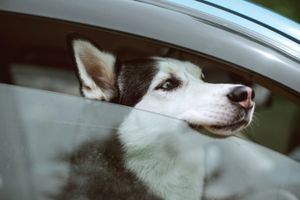Temperatures are rising just about everywhere, and pets can have trouble beating the heat. As you rest in the shade, take a dip in a lake, or sip iced tea, don't forget about your furry friend panting beside you. Pets can easily overheat or develop other heat-related problems while enjoying the fresh air and sunshine. Follow these six tips to keep your pets comfy, cool, and safe during heat waves.

#1: Make sure your pet can escape the outdoor heat
Ensure your yard has plenty of places where your pet can cool down between play sessions. Mature trees, a porch, or a temporary shelter will create a shady escape from the sweltering sun, and a big bowl of cool water will encourage your pet to rehydrate. If your yard is open, without shade, install a doggy door, so your pet can go into your air-conditioned home when they need a break. Never leave your pet tethered outside in the sun or unattended for long periods because heat stroke signs can develop quickly.

#2: Exercise your pet when it's cooler outside
Your pet can quickly become overwhelmed by the heat and humidity as they do not sweat as we do. Take your daily walk or jog in the early morning or evening hours when the sun isn't so intense, and the air is cooler. Before you set out, ensure the pavement is not too hot and won't burn your pet's sensitive paw pads. And, don't forget about your pet outside in the backyard, running along the fence with the neighbor's dog. Keep an eye on your pup, and bring them in frequently for breaks from the heat since they probably won't think to do so on their own.

#3: Recognize heat exhaustion signs in your pet
If your pet overdoes it, and their internal body temperature rises above normal, they will start to look and feel ill. Monitor your pet for heat exhaustion signs so you can cool them down before deadly heat stroke sets in.
Pets with heat exhaustion show signs that may include:
- Excessive panting (even in cats)
- Thick, stringy drool
- Weakness or stumbling
- Vomiting
- Diarrhea
- Lack of coordination
If your pet shows heat exhaustion signs, take them inside and begin cooling actions immediately to prevent progression to heat stroke. Cooling actions: If you are lucky enough to have a pool or be near a lake, you'll probably be tempted to jump in with your dog. If your dog is really hot or bordering on heat stroke, it just might make things worse. Lowering your dog's skin and surface temperature too abruptly might actually result in further heating of his internal organs, worsening the overheating of the body's core.
Instead, recognize that your dog's feet help regulate body temperature. Let the dog stand with just their feet in cold water. You can use a child's wading pool for this.
No access to a pool or lake? Then use the tub or create a breeze with a mist using a fan and a water bottle to help cool your pet. The latter technique is easier for cat owners.
Finally, offer plenty of fresh cool water to help cool down internal temperatures. Always visit your veterinarian after cooling your pet to ensure the episode did not cause internal organ damage.

#4: Know if your pet is prone to overheating
Any pet can overheat if they are too active in the heat or humidity.
Some pets are at higher risk of heat exhaustion and require a closer eye, including:
- Brachycephalic breeds, such as Bulldogs, Pugs, Shih Tzus, and Persian cats
- Senior cats and dogs
- Overweight pets
- Pets with chronic diseases, such as heart disease
- Pets with breathing difficulties, such as those with laryngeal paralysis or collapsing trachea
Brachycephalic pets are at the highest risk of overheating because, along with a blunted muzzle, they also have shorter nasal passages. Since pets rely on moisture evaporation from their oral and nasal passages to cool themselves, they cannot cool off efficiently and easily overheat. High-risk pets should be taken out only for quick potty breaks on hot, humid days to prevent an emergency.

#5: Never leave your pet in a parked car
An unfortunate number of pets will overheat and die in hot vehicles each year. Your car's interior can reach dangerously high temperatures in a matter of minutes on a hot day. Leaving the AC running with a dog in the car does not mitigate the risks caused by rising temperatures within the vehicle. It creates a false sense of security and is unsafe. Veterinarians advise against it due to air conditioner failures (including car gas running out), dogs knocking it off accidentally, and auto shut-off in certain vehicles. Leave your pet at home while you run errands, so you aren't tempted to quickly run into a store and leave your best friend inside a virtual oven.

#6: Make cooling off fun for your pet
Your backyard is full of summer toys for your kids, but what about your four-legged family member? Many dogs enjoy playing in a kiddie pool full of cool water or running through a sprinkler. You can also head to your favorite watering hole to let your water-loving pooch take a refreshing dip—but keep them on a long tether if you are unsure whether they can swim. Kids love to cool off with a popsicle, so make pet-friendly "popsicles" for your dog by freezing yogurt and fresh fruit in ice cube trays. Your cat may enjoy licking an ice cube made from chicken broth or water flavored with tuna juice.
Follow these tips to ward off the heat, so you and your pet enjoy these final days of summer. If, despite your best efforts, your furry friend lands themselves in trouble, call us right away.

